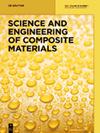Analysis of material removal process when scratching unidirectional fibers reinforced polyester composites
IF 1.6
4区 材料科学
Q3 Materials Science
引用次数: 0
Abstract
Abstract In this study, the micromechanical scratch behavior of unidirectional glass fiber reinforced polyester (GFRP) using several wear conditions was highlighted. Single-indenter scratch tests (SSTs) were carried out on GFRP composite material perpendicular (SST⊥) and parallel (SST//) to fiber direction. Damage modes dominating the material removal process (MRP) and friction exhibit significant sensitivity to both attack angle and normal load. From findings, damage modes and apparent friction coefficient substantially accentuate when increasing the attack angle. The inspections of the damage state at different testing conditions using a scanning electron microscope (SEM) reveal the dominating modes governing the MRP through the different phases. The response surface methodology (RSM) was adopted to develop a mathematical model based on the measured data. The RSM approach was found very promoting for predicting friction evolution versus attack angle and normal load. The proposed model reveals good ability not only in predicting apparent friction coefficient but also in detecting separately its ploughing and adhesive component. To emphasize the correlation between friction coefficient and MRP, the wear maps have been drawn up.单向纤维增强聚酯复合材料刮擦时材料去除过程分析
摘要在本研究中,重点研究了单向玻璃纤维增强聚酯(GFRP)在几种磨损条件下的微观力学划痕行为。对玻璃纤维增强塑料复合材料进行了与纤维方向垂直和平行的单压头划痕试验。主导材料去除过程(MRP)和摩擦的损伤模式对攻角和法向载荷都表现出显著的敏感性。研究结果表明,当攻角增大时,损伤模式和表观摩擦系数显著增强。使用扫描电子显微镜(SEM)对不同测试条件下的损伤状态进行检查,揭示了通过不同阶段控制MRP的主要模式。根据实测数据,采用响应面法建立了数学模型。RSM方法被发现在预测摩擦随攻角和法向载荷的演变方面非常有促进作用。该模型不仅具有良好的表观摩擦系数预测能力,而且能够分别检测其犁削和粘着成分。为了强调摩擦系数与MRP之间的相关性,绘制了磨损图。
本文章由计算机程序翻译,如有差异,请以英文原文为准。
求助全文
约1分钟内获得全文
求助全文
来源期刊

Science and Engineering of Composite Materials
工程技术-材料科学:复合
CiteScore
3.10
自引率
5.30%
发文量
0
审稿时长
4 months
期刊介绍:
Science and Engineering of Composite Materials is a quarterly publication which provides a forum for discussion of all aspects related to the structure and performance under simulated and actual service conditions of composites. The publication covers a variety of subjects, such as macro and micro and nano structure of materials, their mechanics and nanomechanics, the interphase, physical and chemical aging, fatigue, environmental interactions, and process modeling. The interdisciplinary character of the subject as well as the possible development and use of composites for novel and specific applications receives special attention.
 求助内容:
求助内容: 应助结果提醒方式:
应助结果提醒方式:


